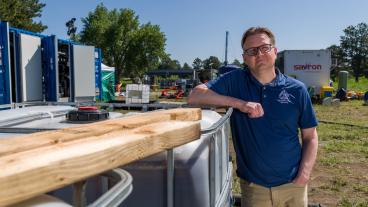.jpg)
Diego Gómez-Gualdrón, assistant professor of chemical and biological engineering at Colorado School of Mines, has been awarded National Science Foundation CAREER funding for work to accelerate the synthesis of new metal-organic framework materials.
Metal-organic frameworks, or MOFs, are porous crystal materials that scientists believe could revolutionize energy storage, chemical separations and more. But very few MOFs have made the jump from computer-based prototype to synthesized reality — a disconnect that Gómez-Gualdrón hopes to close using the power of molecular simulation and machine learning.
The project, “Introducing synthetic feasibility predictions in large-scale computational screening of open-framework materials (OFMs),” will receive $506,000 in NSF funding over five years.
"Metal-organic frameworks can be made in millions of different 'recipes' and could enable technology breakthroughs in areas such as energy storage, chemical separation and catalysis. However, we first need to find the right 'recipe' for each application," Gómez-Gualdrón said. "Modelers have developed ways to build MOF prototypes in the computer, creating large databases that are then screened for the application of choice using molecular simulation. However, synthesis for an identified MOF prototype is rarely attempted due to uncertainty on whether the prototype is actually synthetically accessible."
To address that uncertainty, Gómez-Gualdrón and his team will use machine learning and molecular simulation to help researchers identify in advance which MOF prototypes are the best candidates for synthesis.
The promise of MOFs lies in their unique structure — the porous crystals are not unlike the sponge next to your kitchen sink, only their pores are smaller than a hair is thick, uniform in size, and extremely tunable, he said.
"Conceptually, you can almost build them like Legos, but with metallic clusters and organic ligands being the building blocks. By changing your building blocks, you can manipulate the MOF structure to change the way molecules adsorb, diffuse or react inside the pores," he said. "To store hydrogen, for example, you want to change the structure so there is a lot of space for molecules to go in but also provide enough material so those molecules have something they can stick to. A material with those characteristics will have a lot of internal surface area. It turns out that if you were to unravel the surface area inside a gram of MOF, you could cover a whole football field — that's a remarkable property."
Gómez-Gualdrón and his team plan to build a large database consisting of MOFs that have already been synthesized along with MOF prototypes sharing the same 'recipe' but that for some reason have not been detected during synthesis. The idea is to use state-of-the-art molecular simulation methods to find out what differences there are between the MOFs that have been synthesized and those that have not, as there could lie the key to predict if a prototype could be realized in the lab.
The most ambitious goal of the team is to develop a machine learning algorithm that can tell the difference between the MOFs that have been proven out in the lab and those that have not, based on thermodynamics, kinetics and other factors.
"Ultimately, we want to change the way experimentalists interact with computational MOF databases. We would like them to not only see the expected performance of a MOF prototype but also how likely is that synthesis attempts will result in the desired material," Gómez-Gualdrón said. "This could have an impact on the pace at which MOFs are discovered for different technologies, as more labs around the world — including labs with more modest resources — will feel more confident in investing time and money in pursuing the synthesis of a particularly promising prototype, if there is some reassurance that a material that caught their eye can be made."
As part of the project, Gómez-Gualdrón plans to build an educational website on MOFs targeted at students in high school and college. On the site, students will be able to learn about the properties of MOFs and then get a chance to try to build their own.
"The idea is they will start to build this intuition on what makes a material better than others — when I put this particular chemistry, the performance of the material goes up or when I use a molecular building block of this particular size or shape, I do worse," he said.
Gómez-Gualdrón joined the Mines faculty in 2016 after completing postdoctoral research at Northwestern University. He holds a PhD in Materials Science and Engineering from Texas A&M University and a BS in Chemical Engineering from Universidad Industrial de Santander.
CONTACT
Emilie Rusch, Public Information Specialist, Communications and Marketing | 303-273-3361 | erusch@mines.edu
Mark Ramirez, Managing Editor, Communications and Marketing | 303-273-3088 | ramirez@mines.edu



